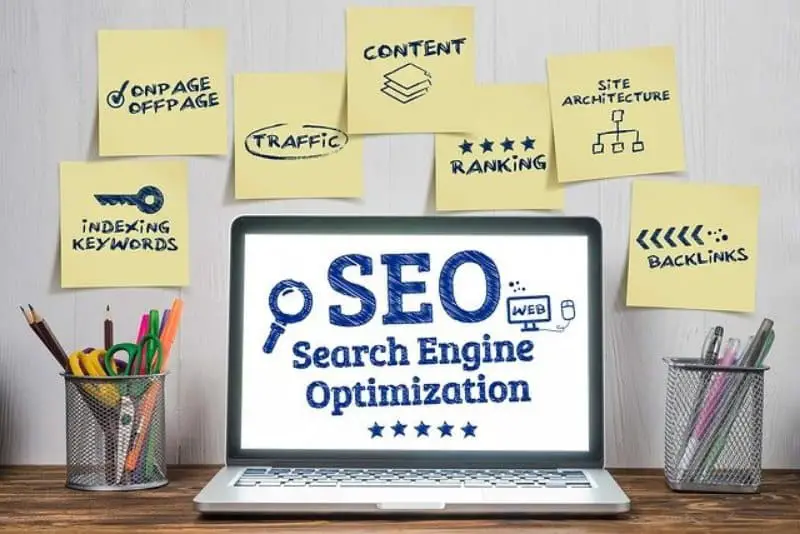The web is chock-full of content, and search engines use certain digital “creatures” to sift through it. These known as web crawlers, bots, or spiders, are like diligent librarians who tirelessly roam through the vast digital library of the internet, stumbling upon new web pages. Once they discover this new content, like a book in a library, it’s stored in an index making it accessible for everyone searching. To ensure your ‘book’ isn’t neglected on a dusty shelf, there are tactics you need to employ. Ready to keep your digital content tidy and attractive? Let’s start with understanding these web crawlers further.
Search engines discover your content by using crawlers, also known as bots or spiders, which follow links from other web pages to reach your site. It’s important to ensure that your website has a clear and crawlable link structure, as well as submitting your sitemap to search engines for proper indexing.

How Search Engines Discover Content
When we talk about search engines discovering content, it’s not like deploying a team of people to explore the internet. Instead, search engines use web crawlers, also known as bots or spiders. These are like digital explorers that systematically browse the internet, following links from one web page to another. Imagine them as little creatures scurrying around the vast web of interconnected pages.
So, when a web crawler lands on a web page, it reads the content and follows any links on that page to other pages. It’s like following a trail of breadcrumbs through the internet. When it discovers a new page, it downloads a copy of it and indexes its content. Indexing is like cataloging every piece of information so that it’s accessible through search engine results when someone asks for it.
The Process in Action

Let’s say you have a website dedicated to baking tips, and you publish a new article about making the perfect chocolate cake. When a web crawler lands on your homepage, it follows the link to your new article. As it reads through your new content, the web crawler picks up relevant information like keywords and phrases related to chocolate cakes.
Once this information is gathered, it’s added to the index. This means that when someone searches for “how to make a chocolate cake,” your article has a chance to appear in the search results because its content was discovered and indexed by the web crawler.
This way, when users type in their search queries, they are presented with relevant results based on what has been discovered and indexed by these web crawlers. Understanding this process is crucial for website owners as they can optimize their content so that it’s more easily discovered by web crawlers, leading to better visibility in search results.
In essence, the discovery process is all about laying breadcrumbs through the internet—creating connections through links and providing valuable information for web crawlers to find. This is how a website makes itself known in the vast digital landscape and becomes accessible for users seeking relevant content.
The Role of Web Crawlers and Indexing

Web crawlers, also known as spiders or bots, are the digital wanderers of the internet, tirelessly navigating through web pages to gather information. Much like the web-crawling bugs after which they are named, these specialized programs possess the ability to systematically scan and index a vast array of online content.
The primary function of a web crawler is to browse the internet and collect data from different websites. This data collection is essential for search engines because it enables them to deliver relevant results based on user queries. Once a web crawler discovers a new page, it reads and analyzes its content to better understand it.
After analyzing the content, the web crawler then follows hyperlinks on the page to discover new ones. This process continues, allowing the web crawler to map out the interconnected structure of the web. It’s like an explorer traveling through a vast network of interconnected roads, stopping at each intersection to chart a path through the expanding terrain.
Imagine web crawlers as diligent librarians meticulously cataloging every book in a vast library. They work tirelessly to index each book’s title, author, and content, making it easily retrievable when someone walks in looking for information on a specific topic.
As the web crawler collects data and follows these trails of digital breadcrumbs, it builds a comprehensive index of web pages. This index serves as a database containing detailed information about the content of each page, enabling search engines to quickly retrieve relevant pages based on user queries.
This indexing process is fundamental for search engines to provide accurate and timely results when users enter search queries. When you type in keywords or phrases, search engines sift through their indexes to locate the most relevant web pages with matching content.
Understanding this process sheds light on how crucial web crawling is for ensuring that search engines have up-to-date information about an ever-expanding digital landscape. Web crawling plays an indispensable role in maintaining the effectiveness and efficiency of search engines by constantly updating their indexes with fresh content and keeping pace with the dynamic nature of the internet.
Now that we understand the pivotal role of web crawlers in indexing web content, let’s explore how different types of content are discovered and made visible on the internet.
Content Types and Their Visibility

When it comes to creating content, there are many different types out there, and each one needs to be discovered by search engines in its own way. Let’s look at how various content types can be optimized for search engine visibility.
Textual Content
Text is the most common form of content on the internet. Whether it’s a blog post, article, or webpage, it’s crucial to use descriptive titles and headings that include relevant keywords. Additionally, creating high-quality, well-structured content with proper formatting (such as using bullet points, numbered lists, and subheadings) can improve its search visibility.
For instance, when writing a blog post about SEO strategies, using a title like “Top 10 SEO Strategies to Boost Your Website Traffic” is more descriptive and keyword-rich than a generic title like “SEO Tips.” This helps search engines understand what the content is about and display it in relevant search results.
Visual Content
Images and videos are becoming increasingly important in online content. Optimizing images involves using descriptive file names, including alt text (alternative text descriptions), and providing captions or surrounding text that provides context to the image. Alt text helps search engines understand what the image is about and improves its chances of being included in image search results.
Similarly, videos should have transcripts to accompany them. These transcripts not only make the video accessible to a wider audience but also provide text-based content that search engines can index. Including relevant keywords in video titles and descriptions can also enhance their discoverability.
Interactive Media
Interactive media, such as quizzes, games, and interactive infographics, can engage users and keep them on your site longer. To ensure this type of content is visible to search engines, descriptive titles with relevant keywords should be used. Providing clear instructions for interactive elements can also help search engines understand what the content is about.It’s important to remember that optimizing different content types goes beyond just including relevant keywords. Each type requires specific attention to maximize its visibility to search engines. By understanding these strategies and implementing them effectively, you can improve the discoverability of your varied content offerings.
Understanding how different content types are discovered by search engines provides valuable insight into the importance of optimizing each type for better visibility. By utilizing descriptive titles, relevant keywords, proper formatting, alt text for images, transcripts for videos, and clear instructions for interactive media, you can significantly enhance the discoverability of your diverse content.
With a solid grasp of how various content forms intersect with search engine algorithms, let’s now shift our focus toward fine-tuning our content for optimal exposure in the digital domain.
Optimizing Your Content for Search Engines

When it comes to getting your content discovered by search engines, optimizing it is a vital step in the process. This involves a variety of tactics and strategies that work together to make your content more visible to potential readers and customers.
One of the first steps in content optimization is conducting keyword research. This involves identifying the specific words and phrases that your target audience uses when searching for content like yours. Tools like Google Suggest, Semrush, and Ubersuggest are incredibly helpful in this process. By understanding what keywords are relevant to your audience, you can tailor your content to match those search queries, making it more likely to appear in search engine results pages (SERPs).
Once you’ve identified the keywords relevant to your audience, the next step is on-page optimization. This means incorporating those keywords naturally into your content, including titles, headings, meta descriptions, and throughout the body of the content. It’s important to strike a balance between using keywords effectively and maintaining the readability of your content. When done correctly, on-page optimization not only helps search engines understand the subject matter of your content but also makes it more appealing to potential readers.
However, it’s not just about keywords. The quality of your content matters just as much. Search engines aim to provide users with valuable and informative content that aligns with their intent. This means creating quality content that adds value to the reader’s experience. The focus should be on providing engaging, well-researched, and informative material that addresses the needs and queries of your target audience.
Imagine crafting an ultimate guide or an in-depth analysis that not only answers common questions but goes above and beyond to provide comprehensive insights into a particular topic. This kind of valuable content not only attracts readers but also earns backlinks from other websites, further boosting its visibility in search engine results.
In today’s digital landscape, having mobile-friendly content is non-negotiable. With an increasing number of users accessing the internet through mobile devices, ensuring that your content is accessible and well-presented across different screen sizes is crucial for search engine optimization. This includes responsive design, fast loading times, and easy navigation on mobile devices.
By focusing on keyword research, on-page optimization, quality content creation, and mobile-friendliness, you’re setting the stage for your content to not only be discovered by search engines but also appreciated by your audience for its value and accessibility.
Setting the groundwork for effective SEO practices lays the foundation for maximizing the advantages of SEO-friendly content. Let’s explore how strategic SEO efforts can amplify your digital presence even further.
Advantages of SEO-friendly Content

Creating and maintaining SEO-friendly content can be an incredibly valuable investment for any website or online business. Let’s explore the various advantages in detail.
First off, increased visibility in search results is one of the most obvious benefits of SEO-friendly content. When your content is optimized according to best practices, it has a better chance of ranking higher on search engine results pages (SERPs). This means more people are likely to see and click on your content, leading to a potential increase in organic traffic.
But it’s not just about getting more eyes on your content. Enhanced user experience is another crucial advantage. SEO-friendly content tends to be well-structured, easily navigable, and rich in relevant information. This can significantly improve the experience for visitors to your website, leading to longer average session durations and reduced bounce rates.
In addition to increased visibility and improved user experience, SEO-friendly content often leads to higher organic traffic. By appearing at the top of SERPs for relevant queries, your content becomes more accessible and is more likely to attract clicks from users, resulting in a steady flow of organic traffic over time.
Furthermore, optimizing your content for search engines can also result in the potential for improved conversion rates. When users find your content easily and have a positive experience engaging with it, they’re more likely to take desired actions such as signing up for newsletters, making purchases, or completing other goals you’ve set for your website.
These advantages come together to create a powerful case for investing time and effort into creating SEO-friendly content. The benefits go beyond just search engine rankings—they extend to user satisfaction, traffic growth, and potentially even revenue generation.
The advantages of SEO-friendly content are undeniable. They translate into tangible benefits for both your online visibility and user engagement. Now that we’ve understood these advantages, let’s delve deeper into the strategies for creating and optimizing such content.
Effective Content Management for SEO Optimization
Content Management is akin to nurturing a garden—when done well, your website will flourish. The key to effective content management for SEO optimization is ensuring that your content is not only engaging but also discoverable and easily navigable by search engines.
Regular Content Audits
Regular content audits are pivotal for maintaining an optimized website. Think of it as pruning your garden to promote new growth and remove any deadwood. By assessing the performance of existing content, you can identify areas for improvement, ensure that the information presented is relevant and up-to-date, and align with current SEO best practices. This helps enhance user experience and demonstrate to search engines that your site provides valuable, high-quality content.
Content Hierarchy
Just like a well-organized book, structuring your content with a clear hierarchy is vital. Headings, subheadings, and internal links establish a logical flow for both users and search engines. Search engines use this structure to understand the context, relevance, and relationships between different pieces of content on your site. This not only improves the user experience but also contributes to better indexation and ranking by search engines.
XML Sitemaps
Creating XML sitemaps acts as a guide for search engine crawlers, directing them to important pages and helping them understand the organization of your website. By ensuring that your XML sitemap is up to date and comprehensive, you increase the likelihood of all your pages being discovered and indexed quickly.
URL Structure
A concise and descriptive URL structure is crucial for SEO. Consider URLs as signposts that guide both users and search engines to specific destinations within your website. Clear, descriptive URLs not only contribute to better search engine visibility but also provide users with an accurate idea of what they can expect from the linked page.
Effective content management ensures that your garden (website) remains well-maintained, organized, and easily navigable by both visitors and search engines.
By implementing these effective content management practices, you can cultivate an online environment that delivers valuable content while optimizing its visibility and accessibility for search engines and users alike.
By maintaining a well-structured website with quality content that caters to both user needs and search engine requirements, you lay the foundation for sustainable online growth and visibility.

